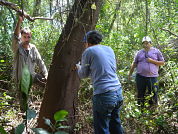Control of Gleditsia triacanthos in the National Park Esteros of Farrapos and Uruguay River Islands
DOI:
https://doi.org/10.25260/EA.16.25.3.0.183Abstract
Invasive species are one of the most important threats to biodiversity conservation. In the National Park Esteros of Farrapos and Uruguay River Islands, the invasion of Gleditsia triacanthos is one of the main threats. We evaluated the feasibility of implementing a control program of G. triacanthos by drilling the stem and applying herbicide. We characterized the regeneration pattern of the woody component and analyzed the herbicide impact on the abundance and number of genus of woody seedlings. The herbicides used were Glifotec and Tordon. After two years of herbicide application the average mortality was 66% and 60% in Glifotec and Tordon, respectively. The regeneration of the woody component is threatened as G. triacanthos accounted for 92% of the individuals. Control did not affect the abundance and richness of seedlings of the woody component. The development of chemical control of G. tiracanthos in the National Park Esteros Farrapos is feasible but requires active restoration management.
References
BLUMETTO, O. 2010. Evaluación de métodos de control de especies exóticas invasoras en monte nativo. Seminario Biodiversidad. Conservación y Usos Sostenible de la Biodiversidad. Maldonado, Uruguay. www.cebra.com.uy/presponsable/adjuntos/2010/04/oscar-blumetto-1.pdf.
BYERS, JE; S REICHARD; JM RANDALL; IM PARKER & C SMITH. 2002. Directing Research to Reduce the Impacts of Nonindigenous Species.Conserv Biol, 16:630-640.
CHANETON, EJ; CN MAZIA; M MACHERA; A UCHITEL & C GHERSA. 2004. Establishment of Honey Locust (Gleditsia triacanthos) in Burned Pampean Grasslands. Weed Technol, 18:1325-1329.
DI MARZIO, W; ME SÁENZ; J ALBERDI; N FORTUNATO; M TANGORRA; ET AL. 2009. Estrategia de manejo de acacia negra (Gleditsia triacanthos) en la cuenca del río Luján. Evaluación ecotoxicológica del herbicida Togar BT. Revista Argentina de Ecotoxicología y Contaminación Ambiental, 1:1-7.
DINAMA. 2014. Plan de Manejo del Parque Nacional Esteros de Farrapos e Islas del Río Uruguay. Dirección Nacional de Medio Ambiente. División Sistema Nacional de Áreas Protegidas. Uruguay.
LEGGIERI, LR. 2010. Invasión de Gleditsia triacanthos en los corredores de los sistemas fluviales de la Pampa Ondulada y su efecto sobre la distribución de Myocastorcoypus. Ecología Austral, 20:201-208.
MARCO, DE & SA PÁEZ. 2000. Invasion of Gleditsia triacanthos in Lithraeaternifolia Montane Forests of Central Argentina. Environ Manage, 26:409-419.
MCDONALD, JH. 2009. University of Delware. SegundaEdición. Handbook of Biological Statistics.Sparky House Publishing Baltimore, Maryland, USA. Pp. 313.
NEBEL, J & J PORCILE. 2006. La contaminación del Bosque Nativo por especies arbóreas y arbustivas exóticas. www.guayubira.org.uy/monte/Contaminacion_monte_nativo_exoticas.pdf.
SABATTINI, RA; S LEDESMA; E FONTANA & JM DIEZ. 2009. Revisión crítica de “Acacia Negra” Gleditsia triacanthos, Leñosa invasora de los sistemas productivos en Argentina. Dow AgroSciences www.dowagro.com/ar/lineadepasturas/trabajos/acacia_negra.htm.
STANLEY, W; S ZEDAKER; J SEILER; & P BURCH. 2014. Methods for Rapid Screening in Woody Plant Herbicide Development. Forests, 5:1584-1595.
TU, M; C HURD & JM RANDALL. 2001. The Nature Conservancy. Weed Control Methods Handbook. tncweeds.ucdavis.edu (version abril 2001).
UNITED STATES DEPARTMENT OF AGRICULTURE (USDA). Natural Resource Conservation Service. 2014. Plant Guide. HoneyLocust. Gleditsia triacanthos. plants.usda.gov/plantguide/pdf/pg_gltr.pdf.
VAN DEN BROEK, T; R VAN DIGGELEN & R BOBBINK. 2005. Variation in seed buoyancy of species in wetland ecosystems with different flooding dynamics. Journal of Vegetation Science, 16:579-586.
VITOUSEK, PM; HA MOONEY; J LUBCHENCO & JM MELILLO. 1997. Human Domination of Earth's Ecosystems. Science, New Series, 277:494-499.
VONENDE, CN. 1993. Repeated-measures analysis: Growth and other time-dependent measures. Chapter 6. Pp. 113-137 en: Scheiner, SM & J Gurevitch (ed.). Design and analysis of ecological experiments. Chapman & Hall, New York.

Downloads
Published
How to Cite
Issue
Section
License
Copyright (c) 2016 Beatriz Sosa, Natalia Caballero, Andrés Carvajales, Gabriela Fernández, Ana Mello, Marcel Achkar

This work is licensed under a Creative Commons Attribution 3.0 Unported License.
Authors retain their rights as follows: 1) by granting the journal the right to its first publication, and 2) by registering the published article with a Creative Commons Attribution License (CC-BY 4.0), which allows authors and third parties to view and use it as long as they clearly mention its origin (citation or reference, including authorship and first publication in this journal). Authors can make other non-exclusive distribution agreements as long as they clearly indicate their origin and are encouraged to widely share and disseminate the published version of their work.


